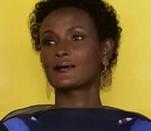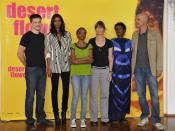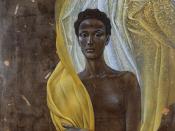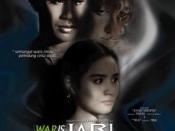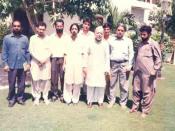" Because of a ritual of ignorance, most of the women on the continent of Africa live their lives in pain." (pg 349) Non fiction narratives are true stories that aim to pass on information, rather than entertain, although they may blend both ingredients successfully. The very definition of non fiction "literary work other than fiction" indicates that the narratives are true in factualism. However, some genres of non-fiction, particularly autobiographies, are one person's recollection and memories and present a ones-sided view. Whereas certain facts are presented much of the way the story is written can convince the reader that everything is true, when it may not be. For example, the autobiography, Desert Flower, written by Waris Dirie, entertains the reader but also sees to inform the reader about a controversial subject. An author can manipulate the truth, by using selection of detail, narratorial stance, language, creative licence and structure of the content.
Non fiction narratives are true stories but the author positions us to respond in a desired way. In some cases, though, such as non-fiction reference books, more factual information is provided and less elaboration given, making the narrative more "ÃÂtrue'.
The subject matter that Waris highlights in her life story is very emotional and can be quite disturbing in places. Waris tells her story in chronological order, from when she ran away from her nomad family in Africa to finding her way to London where she is discovered by a fashion photographer. For most of the book, she bears the recollection and agony of an ancient tradition, female circumcision, performed on her at the mere age of 5. She cannot accept what her family has done to her, so consequently does not forgive them and has no regrets or second thoughts about running away.
"All my life I've tried to think of a reason for my circumcision. Maybe if I could have thought of a good reason, I could accept what they've done to me"æI needed to talk about my secret, because I had it bottled up inside me all my life" (pg 352) Waris also talks a lot about her modelling career and how it has affected her as a person. She had many cultural and health troubles when she first started, but overcame these and consequently became a successful model. She is very grateful that she moved to New York, to escape the poverty and war in Somalia, but she believes she has become a better person because of her childhood experiences.
" Today, I cherish the value of simple things"æthe most valuable asset in life "" other than life itself, is health." Her life story, being told from her viewpoint and relying on her own memory to tell it, suggests that it is accurate and genuine, but the reader can't genuinely believe this because she may have manipulated the truth due to loss of memory.
Waris Dirie uses selection on detail to show the readers that her story is authentic. She passionately describes her circumcision in depth, telling the reader how much it affected her at the time and also in her later life. She explicates this to an extent that we as readers sympathise with her and experience her discomfort and pain.
"My legs were numb, but the pain between them was so intense that I wished I would die" (pg 71) Waris links most of her later life experiences back to her circumcision, especially her health and what she had to undergo to repair the damage from that brutal tradition. She describes this event in her life so realistically that the readers believe it is truthful; it is very difficult to factualize such memories and what Waris chooses to pass onto the reader. Her narrative is true to herself.
The narratorial stance that Waris chooses to use makes the reader think her autobiography is honest. Her own self perspective makes the readers, especially female readers to sympathize with her and want to help her. She also wants us to understand that this devastating ritual is still being performed in Africa and she wants us to help her fight to ban this so that other young girls don't have to experience the pain and consequences. If such a story was told in the third person, the emotional impact on the reader would not be so powerful.
" When I imagine that this year 2 million more little girls will go through what I went through, it breaks my heart. It also makes me realise that each day this torture continues, angry women like myself can never go back and recapture what was taken from them." (pg 358) The use of emotive language in Desert Flower gains the readers sympathy and therefore persuades them to believe the story is veritable. Waris uses the language which is simple and everyday, but also emotional, expressive and interpretive. It is symbolic and significant, which makes the readers feel outrage and anger towards the ancient traditions and sympathy towards Waris. The language paints a powerful image in the readers head, tugging at their heart strings and releasing strong feelings of sympathy and empathy.
"I feel incomplete, crippled, and knowing that there's nothing I can do to change that is the most hopeless feeling of all" (pg 351) This language shows how Waris really felt and prompts the reader to think how arduous her life has been.
"Their role is to clear away carrion, the morbid evidence of our harsh desert existence." (pg 76) This quote shows how Waris despised the desert life, how real her situation was and why she ran away.
Ultimately, non fiction narratives are regarded as true. Most are based on fact but many may be opinionative so the author positions the reader to respond in a desired way, according to his/her own truth. By using emotive language, selection of detail and creative licence, an author can present a truthful account but perhaps not a totally factual account.
